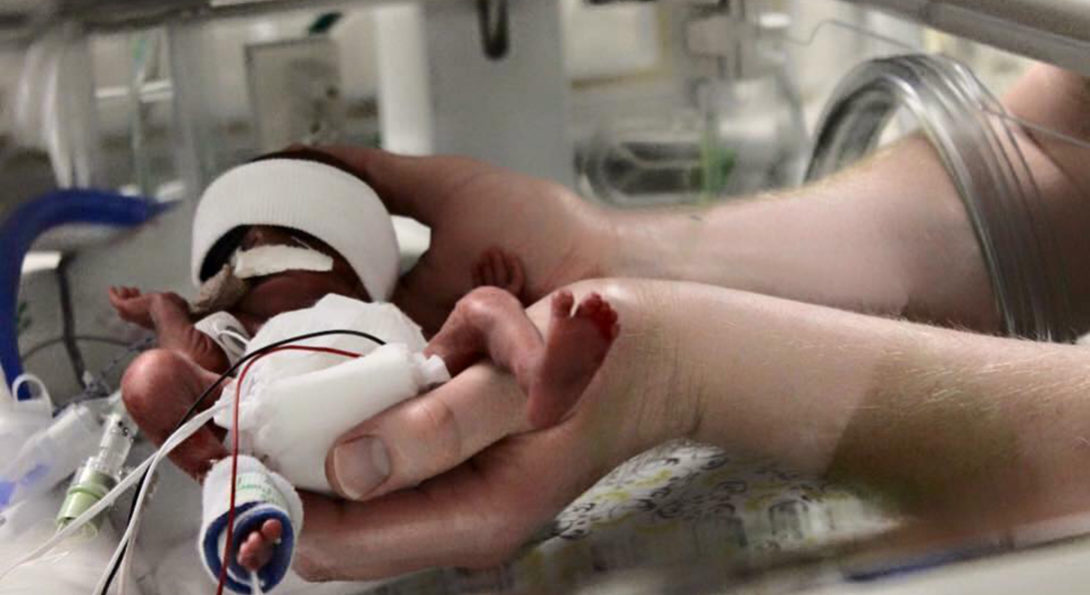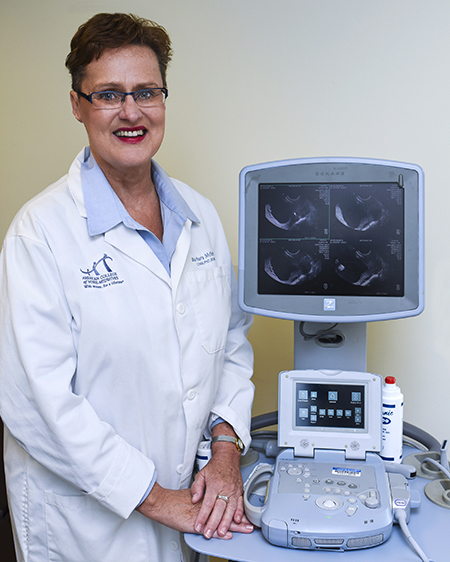A matter of time

With premature birthrates on the rise in the U.S., nurse researcher Barbara McFarlin is seeking a better way to diagnose risk and intervene before it’s too late.
body copy

In the 20th week of an uneventful pregnancy, Rachel Caputo and her husband Tim Carroll arrived at the hospital for a standard ultrasound, excited to learn the gender of their first baby. Thirty minutes later, Rachel was in Labor and Delivery, turned almost vertical on her head, experiencing imperceptible contractions with her baby’s amniotic sac bulging through her cervix. A note revealing the baby’s gender lay in an envelope on the table next to her, the last thing on her mind.
“They told me, very directly, ‘You’re in labor, and your baby is not viable,’” Caputo vividly recalls.
The healthcare team was able to stop her labor, but not for long. London James Carroll was born at “24 weeks and five hours,” Caputo reports, because when you need intervention to stop labor at 20 weeks, you stop counting your pregnancy in months or weeks and start counting hours.
Weighing just 1 lb., 3 oz., London was so small that the delivery team was barely able to intubate her. Eventually, they got her to the neonatal intensive care unit.
“I don’t think any of us thought she was going to live,” says Caputo. She texted a friend in those first days, reporting London’s arrival and adding, “She’s surviving, for now.”
Indeed, London survived quite a lot in the 119 days she was in the NICU. It would be a month before her parents could hold her. She had heart surgery at two weeks and an eye injection at two months. One night around London’s two-month mark, her lung collapsed.
“She was so lifeless and gray. Her oxygen was at three percent. They had to bag her,” says Caputo. “I felt so helpless. I remember almost screaming at her isolette, ‘London, I need you to do this!’ We didn’t think we were coming back from that one.”
How did they get here? Caputo and Carroll expected an easy pregnancy. Herself a picture of health, Caputo exercised regularly, ate a healthy diet, and never smoked or drank alcohol. She and her husband were gainfully employed, with good health insurance. She followed doctors’ orders. Nothing in their past or present could have let them know they were at risk for this eventuality.
What Caputo and Carroll know now is that they are not alone. According to the March of Dimes, 380,000 babies are born prematurely in the U.S. each year. Premature infants, born before 37 weeks of pregnancy, are prone to suffering severe health problems for the rest of their lives, if they survive. These include severe bowel problems, neurological disorders like cerebral palsy, and respiratory problems including asthma and pneumonia. It also means longer hospital stays, which cost upwards of $26 billion each year.
Those 380,000 babies inspire the research of UIC Nursing professor Barbara McFarlin.
“I just think there has to be a better way,” she says.
Not standing for status quo

McFarlin, PhD ’05, MS ’84, BSN ’74, CNM, RDMS, FACNM, FAAN, has dedicated her research career to finding that better way. In September 2017, her work got a big boost as principal investigator on a $2.8 million grant from the National Institute of Child Health and Human Development to develop techniques to accurately predict preterm birth.
Today, McFarlin is head of the Department of Women, Children and Family Health Science, but before joining the UIC Nursing faculty full time in 2005, she worked as a nurse-midwife for 35 years. She says there is currently no reliable indicator for determining preterm birth, except for previous premature pregnancy.
As for treatment once the risk of premature birth is identified, the current protocol is to prescribe progesterone, which costs $1,000 per dose.
“That exasperated me. We give the same expensive medicine at the same dose to everyone,” says McFarlin, “and for many people, progesterone doesn’t even work.”
She wanted to find a way to diagnose the risk earlier, before women had symptoms of premature labor.
“By recognizing which women are at risk, healthcare professionals could provide early interventions, personalized treatments and closely monitor these treatments to prevent preterm birth or to improve health outcomes,” McFarlin says.
Having reviewed thousands of ultrasound scans in her decades as a midwife, she felt certain that changes in cervical tissue held the key to early identification of risk. Prematurity had already been correlated with the attenuation of tissue in the cervix—an increase in water and a progressive disorganization of the collagen content. The reason for this, though, was not well understood because researchers were unable to study the tissue noninvasively in humans.
“For many years, clinicians treated the uterus and cervix as one organ with the same tissue,” says McFarlin, to emphasize how little is known about the cervix. “Only recently did we start to think about the different structures and function of the uterus and cervix. Uterine tissue is composed of smooth muscle, and cervical tissue is mainly connective tissue that needs to keep the fetus inside the uterus until it is mature, then the connective tissue remodels to allow passage of the baby.”
So McFarlin knew she needed to get a better look at the cervical tissue, and she needed a noninvasive way to do it.
Partner makes perfect
Studying cervical tissue noninvasively was going to require a technological solution. To tackle this, McFarlin thought she might benefit from an engineer’s perspective. So she approached William D. O’Brien Jr., now a Donald Biggar Willett Professor Emeritus in Electrical and Computer Engineering at the University of Illinois at Urbana-Champaign. O’Brien is a pioneer in the use of quantitative ultrasound (QUS), and he agreed to help McFarlin in her quest to examine cervical tissue changes.
“Good research happens when people with different skills work together to solve problems,” says McFarlin. “Like nurses, engineers are trained to look at a problem and find a solution. So when we combined the biological knowledge and clinical skills of a nurse with the technical skills and analytical thinking of an engineer, we were able to find a better way to do things.”
O’Brien developed a QUS software that can be added to any ultrasound machine to investigate tissue structure. McFarlin’s use of it in her 2005 dissertation research, studying collagen remodeling in pregnant rat cervices, was the first-ever use of QUS in pregnancy. (O’Brien is now using the same technology to study fatty liver tissue as an early indicator of obesity. “It is thrilling that our findings are so readily translatable,” says McFarlin.)
She took her early findings and expanded her study to include pregnant women, using the same noninvasive procedure she used in the animal model.
“At 17 to 20 weeks of pregnancy we were able to predict who was going to deliver preterm,” McFarlin said. “We found that before the length of the cervix shortens, the microscopic tissue structure has to change and the collagen remodels.”
A study to change practice
With her newly funded study, McFarlin is out to mythbust. There are many assumptions about women who give birth prematurely, including an increased risk due to lack of prenatal care or low socioeconomic status. Caputo’s story alone provides evidence to the contrary.
McFarlin’s earlier studies were relatively small. In her work over the next five years, she hopes to increase dramatically the evidence about who really is more likely to experience preterm labor.
She emphasizes the importance of a diverse team, and hers now includes not only her longtime collaborator and co-principal investigator O’Brien, but also three UIC Nursing researchers: Mulubrhan Mogos, PhD, MSc, assistant professor and the team’s statistician; Patrick Thornton, PhD ’16, CNM, visiting clinical assistant professor and fellow midwife; and sonographer Tara Peters. The team is rounded out with electrical engineer Aiguo Han, PhD, and Alpana Kaushiva, a doctoral student in public health.
O’Brien salutes McFarlin in leading the team. “By any measure, Barbara McFarlin is a very accomplished individual with a wide variety of service-orientated careers,” he says about her practice, teaching and research. “I credit her persistence [in efforts] to benefit others for this successful funding.”
Together the team will study a group of 800 women of various ethnicities and backgrounds—African-American, White, Asian and Hispanic women representing a range of income levels. The research participants will include 400 women with no incidence of premature birth (low risk), 200 who have had previous premature birth (high risk), and 200 who are showing changes in cervical length at 18 to 21 weeks.
During the study, each participant will undergo two ultrasound scans, one at 18 to 20 weeks and one at 24 weeks, both to closely observe changes in cervical tissue. The team will record all data and incidences of premature birth among participants.
In addition to conducting research using ultrasound, McFarlin will learn how the pregnant women respond to progesterone to prevent premature labor, which only reduces the incidences of prematurity by 40 percent. “We want to find out what occurs with the other women and why it does not work,” says McFarlin.
“This is a large study—one that can change clinical practice,” says McFarlin. “I want to be able to diagnose preterm risk early enough to do something about it. I hope we can use our findings to develop personalized treatments and expand the currently available interventions.”
The real impact
“I’m so happy researchers are working on this,” says Caputo enthusiastically, though their experience with London has convinced her and Carroll to forego more children themselves, despite having wanted at least three.
Caputo feels lucky, though. London, now 2 years old, is a happy, smiley toddler who loves to play, dance and watch cartoons. She has challenges, and she will for many years ahead. Her dramatically underdeveloped immune system demands semi-isolation for the family, which isn’t easy, but they are grateful and joyful to have their baby girl at home with them every day.
“No parent should have to hear the words ‘your child is going to die’ before that child is even born,” says Caputo. “I don’t think that should ever happen.”
McFarlin couldn’t agree more.